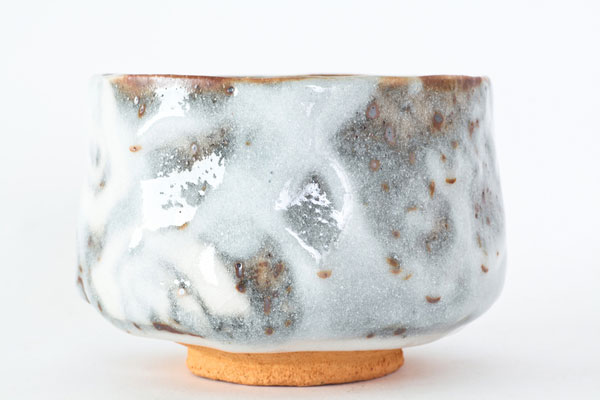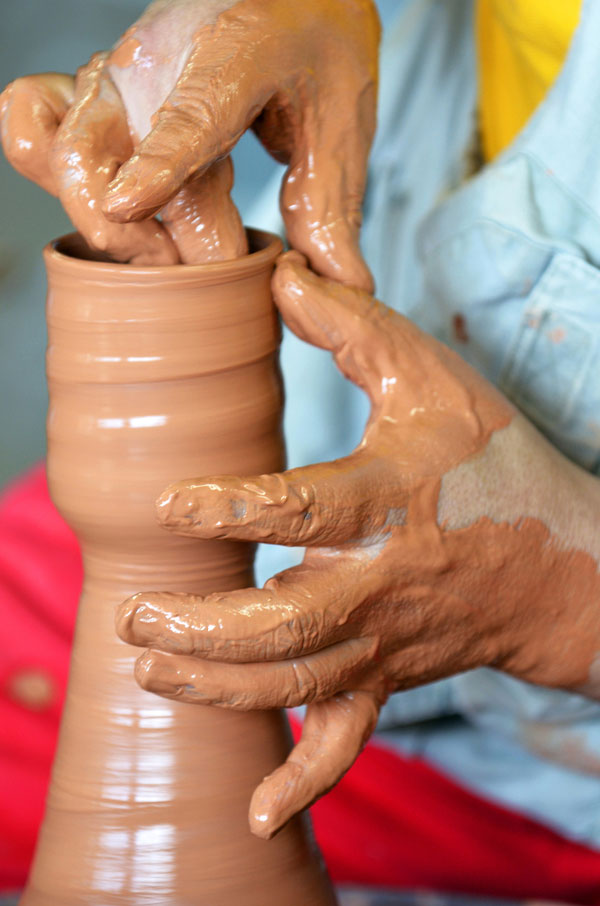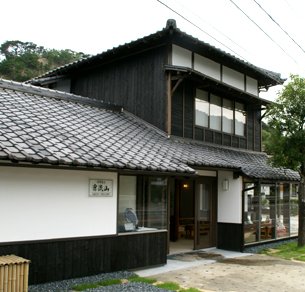
- Ceramic
- Yamaguchi
Hagi ware Hagi yaki
Using this elegant porcelain
will build its character for the best
Description
What is Hagi ware ?
Hagi ware (called Hagi yaki in Japanese) is a form of porcelain produced mainly in the city of Hagi in Yamaguchi prefecture. Hagi ware is rarely decorated, remaining as simple as possible to make the most of the features of the clay. This simplicity creates a unique texture where no two Hagi ware items are the same. The individuality of this porcelain is produced by deep cracks in the clay expanding and contracting the enamel. This results in variations and color changes on the pottery's surface called "the seven disguises" (nanabake). Hagi ware also changes color during its firing, bringing it an unpredictable final touch. Hagi ware is often used for tea bowls that typically have a notched foot. The notched foot design was brought to Japan by the Korean Joseon dynasty (1392-1897) which is also the origin of Hagi ware. There are various theories about the purpose of the notched foot but for Hagi ware, which is otherwise not decorated, they are an important component that changes the whole look of the pottery. Hagi ware uses a clay made of three different soils (daidou, mishima and mitake) which are all extracted from different places. This clay does not shrink much when firing and has a nice texture with excellent heat retention, which is why it is chosen for producing tea ware.
History
The history of Hagi ware goes back to the year 1592, during the Azuchi-Momoyama period (1573-1600) and the Japanese invasion of Korea ordered by Hideyoshi TOYOTOMI (1592–1598), who governed most of Japan at that time. The culture of the tea ceremony was given great importance at that time, and the Korean dynasty of Goryeo (918–1392) had produced highly prized tea ceremony bowls. Toyotomi instructed the feudal lords to bring back Korean potters to teach their knowledge in Japan, and as a result many potters moved from Korea to Japan. In 1604, at the beginning of the Edo period (1603-1868), potters Ri Shyakko and Ri Kei moved to Hagi from the Korean Joseon dynasty (1392-1897), having been brought by Terumoto MORI, who would later go on to found the Hagi domain, and it is said that the roots of Hagi ware lie in the kilns that they built. At first, the techniques used for the Goryeo dynasty tea bowls were kept unchanged, but various schools with different techniques and designs were later created. There was also a reappraisal of traditional culture in the latter part of the Meiji period (1868-1912) and a new style was produced by Kyuusetsu MIWA. Moving into the Taisho period (1912-1926), Hagi ware was so popular that it became a preferred type of pottery by Japanese tea ceremony experts who use an expression that goes, "First Raku, second Hagi, third Karatsu". Rapid economic growth in the postwar period led to the continued development of Hagi ware and in 1957 it was nominated for selection as an Intangible Cultural Asset. Also, recognition as Living National Treasures was accorded to Kyuuwa MIWA (a descendant of Kyuusetsu MIWA) in 1970 and to Jusetsu MIWA (the son of Kyuuwa MIWA) in 1983. Living National Treasure is a title bestowed by the government to groups or individuals who possess skills that are indispensible to produce cultural heritage such as traditional crafts or performance traditions like kabuki theater. Finally, it was designated as a traditional craft in 2002.
General Production Process
 Photo:Yamaguchi Prefectural Tourism Federation
Photo:Yamaguchi Prefectural Tourism Federation
- 1. Raw clay A special clay is created by mixing 3 types of soil (daidou, mishima and mitake) and the mixture is different for each piece. There are cases where the potteries add their own clay into the mixture.
- 2. Straining
Sand and pebbles are removed by drying and pulverizing the original clay and stirring it in a water tank. This is repeated several times until the settled clay is removed and has fully dried.
- 3. Clay stomping
After extracting most of the moisture, the process of "clay stomping" is carried out by placing the clay on a stool and removing air bubbles through stomping, improving the clay's condition.
- 4. Clay kneading
The clay is kneaded by hand and adjusted as its condition is checked. This is carried out 70 to 80 times in one direction, and then 70 to 80 times in another direction.
This process is essential for ensuring that the firmness of the clay is uniform.
- 5. Shaping A shape is created with the clay that has been prepared. The shaping can be done with a potter's wheel, by hand or with a mold.
- 6. Drying in the shade The items that have been shaped are left out to dry in the shade for two to three days.
- 7. Cutting A Japanese plane is used for cutting and adjusting the form. Traditional decorations such as carving and applying brush marks to the foot of bowls and attaching handles for vases are also added at this stage.
- 8. Decoration
While the piece is half-dried, slurry produced by mixing white clay with water is applied and the color of the surface is adjusted too.
- 9. Biscuit firing The piece is fully dried and fired for the first time. This is carried out at a temperature of 700 to 800℃ (about 1292 to 1472℉) for 15 to 16 hours. Biscuit firing is carried out to improve the strength of the piece, but this process may be skipped depending on the purpose of the piece.
- 10. Glazing
Glazes such as ash glaze and straw ash glaze are applied. The firing gives the glaze a glassy surface. Ash glaze gives a transparent finish and straw ash glaze gives a milk white finish.
There are two methods of applying glaze: "complete dipping" in which the piece is submerged in enamel or "ladle dipping" in which enamel is poured onto the piece from a ladle. The appropriate method is selected according to factors like the form of the piece.
- 11. Loading pots into the kiln
Traditional Hagi ware pots are set inside ascending kilns* with multiple small chambers using a method called "balanced loading" in which multiple pieces are piled on top of circular boards. Balanced loading is often used in Hagi ware because it ensures maximum flame entry. However, other techniques may be preferred depending on the situation like "shelf loading" or "saggar loading" where items inside a container are piled up for baking.
After being loaded into the kiln, all areas apart from the horizontal opening for inserting kindling are blocked with bricks and mud.
*An ascending kiln or aragama (meaning cave kiln) is an ancient type of single-chamber kiln built in a sloping tunnel shape. The ascending kiln can reach extremely high temperatures because it uses wood.
- 12. Firing After closing all of the baking chambers, the fire starts from the bottom chamber. The temperature is raised to around 1250 to 1300℃ (about 2282 to 2372℉) for firing. The kiln requires constant all-day supervision while firing because the quantity of firewood must be adjusted based on observing the temperature based on the color of flames. Once the desired temperature is reached, a color sample is pulled out and the condition of the glaze is checked. When the color sample reaches the intended state, the opening is blocked and the fire is put out.
- 13. Removing pieces from the kiln
After putting out the fire and leaving the pieces to cool naturally for a few days, the seal of the entrance is broken in order to remove the pieces.
Leading Ateliers
Senryuzan atelier

From choosing the clay to the firing, all the creation steps are handmade by our artisans.
We use traditional techniques to create deep and meaningful items.
-
Founded1826
-
ClosedWednesdays (if Wednesday is a holiday we open)
-
DirectorHatao YOSHIKA
-
Business Hours9am to 5pm
-
Address
-
Website
-
Tel.+81-838-22-0541
Where to Buy & More Information
Hagiyaki Kaikan
-
Address
-
Tel.+81-838-25-9545
-
ClosedOpen every day
-
Business Hours8:30am to 5pm
-
Website
See more Ceramic
- Imari ware/Arita ware
- Hasami ware
- Kutani ware
- Mashiko ware
- Shigaraki ware
- Bizen ware
- Hagi ware
- Koishiwara ware
- Mino ware
- Tobe ware
- Tokoname ware
- Karatsu ware
- Kasama ware
- Satsuma ware
- Iga ware
- Mikawachi ware
- Agano ware
- Otani ware
- Obori-soma ware
- Tsuboya ware
- Aizu-hongo ware
- Shodai ware
- Echizen ware
- Akazu ware
- Tamba-tachikui ware
- Yokkaichi-banko ware
- Izushi ware
- Kyo ware/Kiyomizu ware
- Iwami ware
- Amakusa ceramics
- Seto-sometsuke ware
- Sanshu Onigawara Crafts































































































































































































































































































